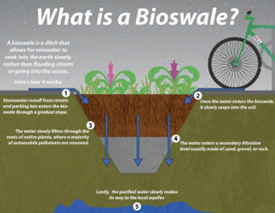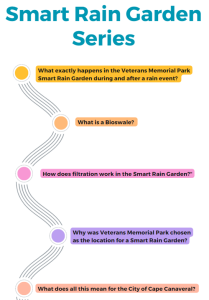 Droppin’ In at the Smart Rain Garden
Droppin’ In at the Smart Rain Garden
#2 in a series of 5 write-ups to introduce the processes and technology at work in the City of Cape Canaveral’s Veterans Memorial Park “Smart” Rain Garden. Please join us for all the posts in this series. The blog series was written by Mandy Baily with assistance from Dan Macchiarella and Tyler Deal with Embry-Riddle Aeronautical University, Zach Eichholz and Tim Carlisle with the City of Cape Canaveral, and Andrew Joesoef with Stetson University. All figures were created, and images taken by Mandy Baily unless otherwise noted.
What is a bioswale?
A Rain Garden also uses the term bioswale (swale means a low place). Both names refer to a vegetated channel, trench, or depression created for collecting rainwater run-off (Figure 1).

In the case of Cape Canaveral’s Smart Rain Garden, native plants are used to vegetate the often-dry swale, specifically plants that can handle the salty air and soil with occasional rain inundation. The hundreds of plants in the ground were chosen for their ability to thrive in local weather conditions and low-nutrient coastal soil (Figure 2). Often, people ask why there is no standing water in the rain garden. To clarify, the rain garden is intended to remain dry unless there is a rain event. It works as it should when rain percolates down into the soil, away from the surface.

Does anyone know how quickly rain seeps into the soil of the Cape Canaveral Rain Garden? With the sensors installed recently, there is insufficient data to offer an average rate. That said, one rain event earlier this summer resulted in an infiltration rate of 66cm in 50 minutes – nearly 26 inches of water! Perhaps this is why many residents regularly comment on how the Rain Garden always appears dry, even shortly after a heavy rain.
Smart Rain Garden Series
Join us for the next blog post in this series, where we’ll talk about “How does filtration work in the Smart Rain Garden?”. Go back to read the other posts in this series.
 1
1

